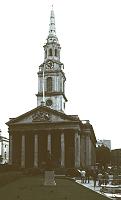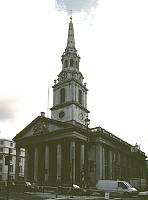


|
The west frontThis is now an important site, on the northeast corner of Trafalgar Square, but the location was more obscure when the church was originally constructed. The design of this church was very influential, partly because engravings of it appeared in Gibbs' book. It became the prototype of Anglican parish churches, particularly the combination of steeple and portico. Gibbs uses the "giant" Corinthian order with an impressive portico on the west end, raised somewhat, and with 6 Corinthian columns. This order continues on the sides with pilasters instead of columns, except for the end bays where two columns are recessed in antis. (See view below.) The tympanum has the arms of George I, the reigning monarch when the church was opened. |
|
Angled view showing the end bay of the nave with recessed columnsUnlike Wren's steeples, which are often separate structural features, Gibbs' tower seems more unified, as if it comes through the roof (or appears to sit on the roof). The actual steeple design does still owe to Wren's designs. (See also his St. Mary le Strand). The nave has two tiers of windows, typical of Georgian galleried churches and the east end has a large Palladian window. |

|
|
 Click here to return to index of art historical sites.
Click here to return to index of art historical sites.
 Click here to return to index of artists and architects.
Click here to return to index of artists and architects.
 Click here to return to chronological index.
Click here to return to chronological index.
 Click here to see the home page of Bluffton College.
Click here to see the home page of Bluffton College.
